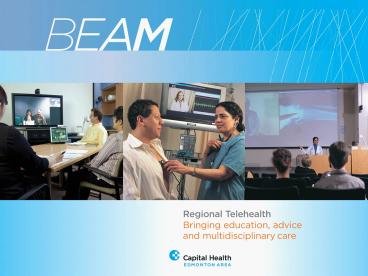TeleStroke in Capital Health - PowerPoint PPT Presentation
1 / 21
Title:
TeleStroke in Capital Health
Description:
75% of survivors live with some level of disability. ... are sent to the A.H Owen & Family Stroke Prevention Clinic at the University ... – PowerPoint PPT presentation
Number of Views:110
Avg rating:3.0/5.0
Title: TeleStroke in Capital Health
1
(No Transcript)
2
TeleStrokein Capital Health
Khurshid Khan, MD, FRCPC Div. of
Neurology University of AlbertaTeleStroke
Physician Lead
3
Impact of Stroke
- Stroke is the 1 cause of acquired adult chronic
disability. - Stroke is the leading cause of death after
cancer and - cardiovascular diseases.
- Most common neurological condition requiring
admission - to hospital
- 20 fatal.
- 75 of survivors live with some level of
disability. - Stroke incidence doubles each decade after age
55.
4
Stroke in Alberta
- 5,500 new stroke case per year.
- 25,000 stroke survivors.
- Cost 300M per year.
- 1-2 increase in the occurrence of stroke per
year for - the next ten years.
5
TIA Facts
- Risk of stroke after TIA or minor stroke is 21.5
over 5 years. - 90 day Stroke risk after TIA 10 12 .
- Half of these occur within 2 days of TIA.
- Early assessment and intervention may reduce the
risk to 2.
6
Stroke Prevention Clinic
- Stroke prevention clinic (U of A) receives over
2300 referrals - / year for assessment of stroke and TIA.
- High volume may result in delay in access.
- Long distances from specialized stroke centers
add to - delayed access.
- 55 of patients seen stroke clinic come from
remote areas. - Inconvenience and stress associated with Long
distance - travel and cost.
7
Objectives of TeleStroke
- To improve timely access to multi-disciplinary,
specialist driven, - investigation and management of acute stroke
and secondary prevention. - To increase capacity for investigation and
management of stroke in the - ambulatory setting.
- To reduce admissions to hospital for stroke
investigation. - To improve patient and family satisfaction with
stroke care. - To increase support to the community managing
stroke patients.
8
TeleStroke Program
- In 2003, CHA launched TeleStroke to extend
specialized - stroke care to patients in remote locations.
- Capital Health provides specialized stroke care
to Northern - Central Alberta including the Territories,
British Columbia - and Saskatchewan.
- Over the past 4 years the TeleStroke program has
expanded - to include an innovative Acute TeleStroke
program, Stroke - Rehabilitation program and Dietician
consultations.
9
Components of the TeleStroke service
- 1. TeleStroke prevention clinic
- 2. Acute stroke care
10
TeleStroke Prevention Clinic
- Consultation process
- Referrals are sent to the A.H Owen Family
Stroke Prevention Clinic at the University of
Alberta Hospital - Triage process by stroke fellows / stroke faculty
- TeleStroke coordinator / assistant
- Remote site
- Potential for 5 day clinic
.
11
TeleStroke Clinic Sites
TeleStroke currently has 52 available sites for
clinic visits.
12
Results
13
TeleStroke Prevention Clinic
- Average time interval 2 weeks.
- More than 95 satisfaction.
- Telehealth seen as an acceptable means of
healthcare - services by both health providers (100) and
patients - (92).
- 83 of patients stated that they preferred a
Telehealth - session to a face-to-face visit in Edmonton.
- Cost saving of 300 700 reported by the
patients.
14
Acute Stroke
- Blood flow must be restored rapidly to prevent
permanent - damage to the brain.
- Time is Brian - window of treatment opportunity
is 3 hrs - from symptom onset.
- Only 2 5 avail thrombolytic treatment.
- One of the major factor is late arrival to
specialized stroke - center.
15
1. Hinton Health Care Center 2. Camrose Health
Care Center 3. Cold Lake Health Care Center
4. Red Deer Hospital
Remote Primary Stroke Care Centers
16
(No Transcript)
17
Acute Program Results
- Rate of thrombolysis
- Average time of onset to patient arrival in
Remote - ER
- Average time from ER arrival to tPA
- Average Baseline NIHHS
- Mean Modified Rankin Scale 90 day post tPA
- 90 day Mortality rate
- Total number of intra - parenchymal Hemorrhage
22.6 vs. 2-5 (Edmonton 19) 90.6 min 78.8
min 16 lt 2 6/29 3/29
18
Dietician Consultations
- The Stroke Prevention Clinic offers dietary
support to patients - who do not have access to a dietician in their
community. - Consultations are arranged by the TeleStroke
Coordinator. - Prior to the Telehealth session, a three day food
diary is sent to - the patient.
- The dietician then reviews the diary and tailors
an individualized - learning plan for each individual.
19
Nursing Education Sessions
- During the Telehealth appointment the
neurologist may - identify some specific education needs for the
patient. - Once identified, the neurologist will then refer
the patient to - the Education program with specific outlined
risk factors. - The TeleStroke Nurse Coordinator then develops
an - individualized interactive learning plan with
specific learning - goals and arranges follow up sessions with the
patient.
20
Conclusion
- TeleStroke is an acceptable alternative for many
stroke - patients from remote areas outside of
Edmonton. - TeleStroke has improved access to specialized
stroke care - for patients from remote Northern Central
Alberta and - beyond providing the entire continuum of stroke
care to - remote patients.
21
Acknowledgements
Tammy Whittaker RN, BScN,Regional TeleStroke
Program Coordinator Johnny Ibrahim Regional
TeleStroke Program Assistant Partnering Primary
Care Centers































